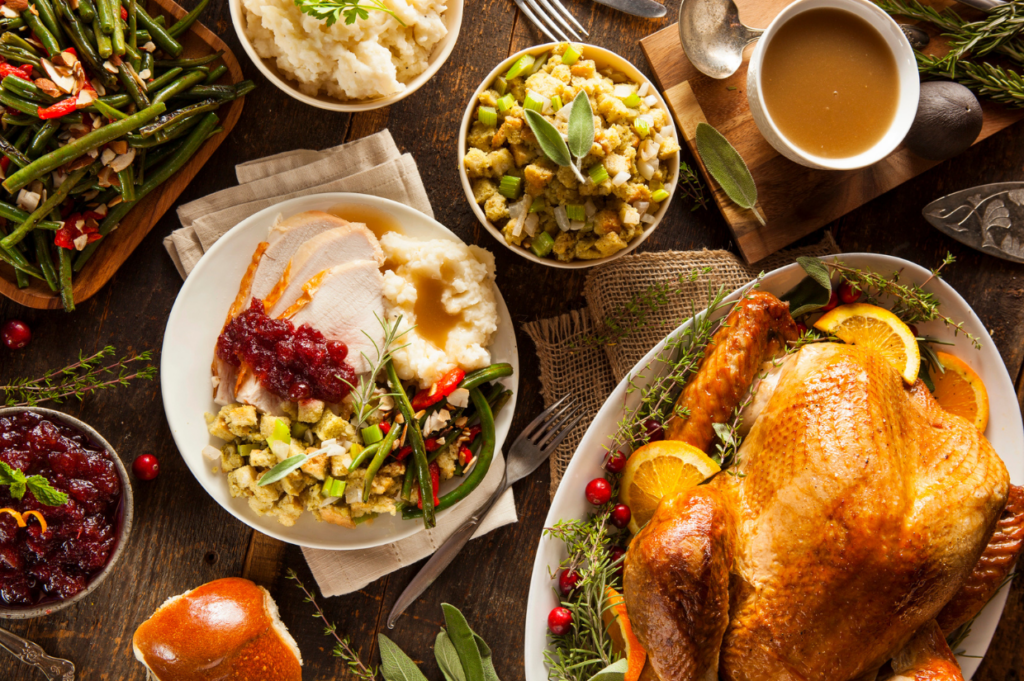The holidays bring the joy of gathering around the table with loved ones to share hearty, flavorful and festive dishes. However, traditional holiday dishes are often high in calories, saturated fats and added sugars. Fortunately, dietitians have plenty of tips to help you make healthier choices without sacrificing taste while cherishing your favorite recipes.

Keep family favorites intact
One of the hallmarks of holiday meals is the cherished family recipes that have been passed down through generations. Family favorites carry sentimental value, and it’s wonderful to let those cherished recipes shine.
Kitty Broihier, certified mindful eating instructor and creator of the Eating Habits Lab, emphasizes the importance of these treasured dishes: “I always say that you don’t fool around with a treasured family recipe. If people are expecting Great Grandma’s stuffing, don’t ‘healthify’ it — make it the way people remember and love.”
She suggests focusing on the accompaniments, such as rolls and appetizers, where healthier tweaks can be easily made. Adding whole grains and vegetables to these recipes can elevate your holiday feast without altering beloved dishes.
Lighten up casseroles and sides
Holiday casseroles can be heavy and rich, often loaded with creamy sauces and calorie-dense toppings. To give these dishes a healthier twist, Jessie Winstead, an Atlanta-based registered dietitian and owner of Health Down South, recommends, “Instead of topping green bean or sweet potato casseroles with fried onions or marshmallows, try using a mix of chopped nuts, like almonds or pecans. This adds healthy fats, fiber and protein for a more nutritious crunch.”
Replacing traditional toppings with chopped nuts and using Greek yogurt instead of heavy cream adds a nutritious crunch and creamy texture. This method enhances your holiday casseroles for everyone.
Nutritious twists for classic sides
For a new take on mashed potatoes, Holli Ryan, a dietitian and contributor at Life Extension, suggests, “Include the skin for smashed potatoes instead of mashed to get additional nutrients found in potato skin. Make oat cookies with walnuts and warming spices instead of sugar cookies for fiber, beta-glucans, healthy fat and added protein.”
According to the American Journal of Potato Research, potato skins are a source of fiber, vitamins and minerals, providing extra nutrients to this well-loved side. If you’re in the mood to shake things up, she also recommends oat cookies with walnuts and spices instead of sugar cookies, offering a festive, nutrient-dense option full of fiber and healthy fats.
Rethink healthy dessert options
Desserts are a holiday highlight but often with extra sugar and fat. For a lighter approach, try portion control, ingredient swaps or seasonal fruits like apples and pears. Cinnamon-baked apples offer a naturally sweet, lower-carb option.
Heidi McIndoo of Apple a Day Nutrition recommends making pumpkin pie without a crust for lower calories and better portion control. She also suggests replacing some butter in stuffing with low-sodium chicken stock to reduce saturated fat while keeping it moist, letting you indulge in a holiday favorite without guilt.
Swap ingredients in holiday main dishes
Modifying ingredients in the main dishes can significantly change the nutritional value without compromising flavor. For instance, replacing regular pasta with whole-wheat pasta in holiday casseroles is a simple yet effective way to increase fiber and nutrients while maintaining the dish’s familiar texture.
Air frying certain dish components can also reduce oil use while providing a crisp and golden finish. For instance, potatoes and vegetables prepared in the air fryer are lighter but still satisfying.
Alyssa Smolen, media and community dietitian and owner of Arugalyssa, adds, “When making a holiday healthier, it’s best to look at what ingredients won’t change the feel of the dish so it still feels comforting and satisfying. For example, swapping whole wheat pasta for white pasta won’t drastically change the taste or consistency of a dish. In addition, if you have the option to air fry components, try air frying.”
Adding seasonal produce for extra nutrients
Seasonal produce is another effective way to infuse holiday meals with extra vitamins and minerals. Simran Malhotra, a plant-based lifestyle advocate and founder of Wellness by LifestyleMD, recommends making creative ingredient swaps for holiday sides like adding riced cauliflower, shredded Brussels sprouts, sauteed mushrooms or walnuts to stuffing for added texture, flavor and nutritional value.
Additionally, incorporating roasted winter squash is another nutritious addition to the holiday menu. Melissa Altman-Traub, a plant-based nutritionist, suggests roasting it with olive oil, salt, pepper and herbs like rosemary or cinnamon for a cozy, savory dish. A hint of orange or pineapple juice can add natural sweetness, creating a balanced dish that brings essential vitamins and minerals to the table.
Concluding tips for healthier holiday meals
The holidays are meant to be enjoyed, and by making thoughtful swaps and additions, you can savor traditional meals with a healthier twist. Whether you add a few vegetables here, substitute a high-calorie ingredient there or experiment with seasonal fruits, small changes can bring balance to holiday feasts. With expert tips and creativity, you can celebrate togetherness while nourishing your body and mind.
Remember, small changes can make a big difference. This allows you to enjoy the occasion without compromising your health.
Lara is a Registered Dietitian Nutritionist and Personal Trainer. She is also a photographer and recipe developer and has a nutrition blog, For Dietitians.
Disclaimer: These statements have not been evaluated by the Food and Drug Administration. The contents of this article are for informational purposes only and do not constitute medical advice. The content presented here is not intended to be a substitute for professional medical advice, diagnosis or treatment. Always seek the advice of a qualified healthcare provider with any questions you may have regarding a medical condition or dietary changes. Reliance on any information provided by this article is solely at your own risk.